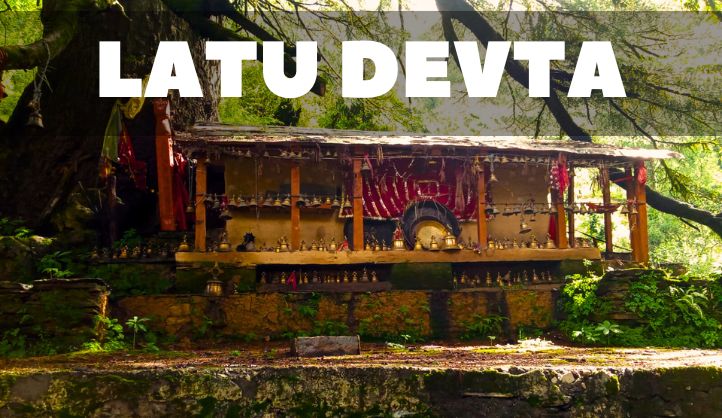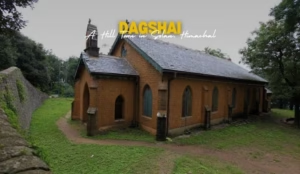In the heart of the Garhwal Himalayas, nestled amidst towering peaks and lush valleys, lies a unique temple shrouded in mystery – the Latu Devta Mandir. Dedicated to the enigmatic Latu Devta, this temple attracts devotees not just for its divine presence but for its unconventional rituals and intriguing legends.
Abode of the Serpent King?
Located in the village of Wan, in Uttarakhand’s Chamoli district, the Latu Devta Mandir sits at a staggering height of 8500 feet. Unlike most Hindu temples, the idol of the deity remains unseen. Devotees offer their prayers from a distance, while the priest who performs the puja (worship) does so blindfolded. Local lore attributes this unusual practice to the presence of a powerful Nagamani (serpent gem) within the temple sanctum. It is believed that gazing upon the gem can lead to blindness.
Who is Latu Devta?
There’s no single definitive story about Latu Devta’s origin. One popular narrative portrays him as the brother of Nanda Devi, the revered goddess of the Garhwal region. According to this tale, Latu Devta served as Nanda Devi’s army commander. During one of her processions, he stopped for the night at Wan village. An old woman offered him water, but there were two pots – one containing water and the other, local liquor. Mistaking the liquor for water, Latu Devta consumed it. As punishment for this transgression, he was condemned to forever reside in the village, protecting its inhabitants.
Another legend suggests Latu Devta was a wandering ascetic who attained enlightenment in the Wan region. The villagers, recognizing his spiritual power, began worshipping him as a deity.
How to Reach
Reaching the Latu Devta Temple requires a moderately challenging trek through the Garhwal Himalayas. Here’s a breakdown of the journey:
Modes of Transportation:
Reaching the starting point of the trek typically involves a combination of public transport and taxis.
Reach Rishikesh: Rishikesh is the most common starting point for reaching the Latu Devta Temple. You can reach Rishikesh by train, bus, or taxi from major cities like Delhi, Haridwar, or Dehradun.
Rishikesh to Karnprayag: From Rishikesh, take a shared taxi or bus to Karnprayag, a town located on the confluence of the Alaknanda and Mandakini rivers. The journey takes approximately 4-5 hours.
The Trek:
Karnprayag to Wan Village: The trek to Wan Village, where the Latu Devta Temple is situated, is about 18 kilometers. It’s an uphill climb, so be prepared for a physically demanding journey. You can opt to hire a porter to carry your luggage. The trek typically takes 6-8 hours, depending on your pace and fitness level.
Important Considerations:
- Time of Year: The Latu Devta Temple opens only once a year during the Nanda Devi Raj Jaat Yatra, a pilgrimage that culminates in Wan village. This usually happens every twelve years. Plan your trip accordingly.
- Physical Fitness: The trek is challenging, with steep inclines and uneven terrain. Ensure you’re in good physical condition before attempting it.
- Accommodation: Limited accommodation options are available in Wan village. Homestays are the most common choice. Consider booking in advance, especially during the pilgrimage.
- Permits: You might need to obtain trekking permits depending on the specific route you choose. Check with local authorities for the latest requirements.
Additional Tips:
- Pack comfortable hiking shoes with good grip.
- Carry warm clothing as temperatures can drop significantly at higher altitudes.
- Bring a backpack with essentials like water, snacks, sunscreen, insect repellent, and a first-aid kit.
- Hire a local guide if you’re unfamiliar with the terrain.
Reaching the Latu Devta Temple requires dedication and preparation. However, the experience of witnessing this unique temple and its rituals amidst the breathtaking Himalayan landscape is an unforgettable one.
A Festival Steeped in Tradition
The Latu Devta Mandir opens its doors only once a year, coinciding with the Nanda Devi Raj Jaat Yatra, a revered pilgrimage. This twelve-year procession culminates in Wan village, where the Devta is believed to greet his sister Nanda Devi. On this auspicious day, a grand mela (fair) is held, attracting devotees from far and wide.
The puja rituals are a sight to behold. The priest, blindfolded with a cloth, approaches the temple chanting hymns. It is believed that the divine guides his steps. Offerings of flowers, fruits, and sweets are made, followed by the recitation of sacred texts like the Vishnu Sahasranama (thousand names of Vishnu) and Bhagwati Chandika (hymns to the fierce aspect of Durga).
Beyond the Blindfold: Faith and Mystery
The blindfolded priest practice is a central element of the Latu Devta legend. Some believe it’s a symbolic gesture, representing faith and devotion. The priest, unable to rely on sight, surrenders to the divine, performing the puja with his inner vision and unwavering faith.
Others hold onto the belief of the Nagamani, adding an element of mystery and awe to the rituals. This belief system resonates with the ancient reverence for serpents in Hindu mythology, where they are often associated with powerful deities and hidden treasures.
A Testament to Local Culture
The Latu Devta tradition transcends a mere religious practice. It’s a vibrant expression of the unique culture and folklore of the Garhwal region. The annual festival strengthens social bonds as villagers come together to celebrate their shared faith. The stories surrounding Latu Devta passed down through generations, weave a rich tapestry of local history and beliefs.
A Destination for the Intrepid Traveler
For the adventurous traveler seeking a glimpse into the heart of Himalayan spirituality, the Latu Devta Mandir offers an unforgettable experience. The breathtaking backdrop, the unique rituals, and the captivating legends combine to create a pilgrimage unlike any other.
Important Considerations
If you plan to visit the Latu Devta Mandir during the annual festival, be prepared for a challenging journey. The trek to Wan village is arduous, requiring a good level of physical fitness. It is crucial to respect local customs and dress modestly. Photography inside the temple premises is strictly prohibited.
The Enduring Legacy of Latu Devta
The Latu Devta tradition embodies the essence of faith transcending the physical realm. It’s a testament to the enduring power of local beliefs and the vibrant cultural tapestry of the Garhwal Himalayas. Whether you see Latu Devta as a historical figure, a mythical guardian, or a symbolic representation of divine power, his legacy continues to inspire and intrigue devotees and travelers alike.
Unveiling More Layers: Exploring the Unexplained Aspects of Latu Devta
The story of Latu Devta doesn’t end with the annual festival and its intriguing rituals. Several mysteries continue to shroud the deity and the temple, sparking curiosity and inviting further exploration.
The Unseen Idol
The most striking aspect of the Latu Devta Mandir is the absence of a visible idol. Unlike most Hindu temples with elaborate murtis (idols), Latu Devta remains unseen. This absence fuels speculation. Some believe there’s no physical idol at all, and the focus is purely on the divine energy residing within the sanctum. Others suggest the presence of a formless representation, perhaps a symbolic object or a sacred relic.
The Nagamani Enigma
The legend of the blinding Nagamani adds a fantastical element to the Latu Devta lore. While there’s no scientific evidence to support its existence, the belief holds significance. It highlights the association of serpents with divinity and hidden treasures in Hindu mythology. The Nagas, a race of wise serpent beings, are often depicted as guardians of sacred knowledge and powerful gems. The Latu Devta legend could be a local interpretation of this ancient belief system.
The Restricted Access
The limited access to the temple sanctum further fuels the mystery. With only the blindfolded priest allowed inside, the details of the interior remain shrouded in secrecy. This restricted access could be attributed to the sanctity of the space or perhaps the desire to preserve the mystery surrounding the deity. However, it also sparks curiosity about what lies within the temple walls.
The Unexplored Legends
The existing narratives about the Devta offer a glimpse into his origins and significance. However, there’s a possibility that other stories exist, perhaps passed down orally within the local community. Further research among the village elders and exploration of regional folklore could potentially uncover new facets of the Latu Devta legend.
The Potential for Archaeological Exploration
The temple’s location in the Himalayas adds another layer of intrigue. The region has a rich history, with ancient settlements and lost civilizations. While there’s no concrete evidence linking Latu Devta to any specific historical period, some speculate that further archaeological exploration in the vicinity could reveal clues about the origins of the temple and the deity it worships.
Latu Devta in the Modern World
The Latu Devta tradition continues to adapt to the modern world. Social media has played a role in spreading awareness about the temple and its rituals. Travel bloggers and vloggers document their experiences, attracting a new generation of curious explorers. While some purists may view this with concern, it also ensures the continuation of this unique tradition in the digital age.
The Importance of Preservation
As the world becomes increasingly interconnected, it’s crucial to preserve the unique cultural heritage of local communities. The Latu Devta tradition, with its distinct rituals and captivating legends, is an important part of the Garhwal region’s identity. Supporting local initiatives that document and promote this tradition can ensure its survival for future generations.
Conclusion
The story of Latu Devta is more than just a religious practice. It’s a portal to a world steeped in folklore, cultural beliefs, and a deep connection to the natural world. While some aspects remain unexplained, the very act of exploration deepens our understanding of the multifaceted nature of faith and spirituality. Whether seeking answers to the mysteries or simply appreciating the beauty of the tradition, the Latu Devta Mandir beckons the curious traveler on a journey beyond the obvious.
FAQs About Latu Devta
1. Who is Latu Devta?
Latu Devta is an enigmatic deity worshipped in the Garhwal Himalayas. There are multiple stories about his origin – some portray him as the brother of Nanda Devi, a revered goddess, while others suggest he was a wandering ascetic.
2. What’s unique about the Mandir?
Unlike most Hindu temples, the idol of Latu Devta remains unseen. The priest performing the puja is blindfolded, adding to the mystery. Legends attribute this to the presence of a powerful Nagamani (serpent gem) within the temple.
3. When can you visit the Mandir?
The temple opens only once a year during the Nanda Devi Raj Jaat Yatra, a pilgrimage that culminates in Wan village. This typically occurs every twelve years.
4. What are some things to keep in mind while visiting?
The trek to Wan village is challenging, so be prepared for a physically demanding journey. Dress modestly and respect local customs. Photography inside the temple is strictly prohibited.
5. Why is Latu Devta significant?
The Latu Devta tradition transcends religion. It’s a vibrant expression of Garhwali culture, showcasing unique rituals, captivating legends, and a deep connection to the Himalayan way of life.





